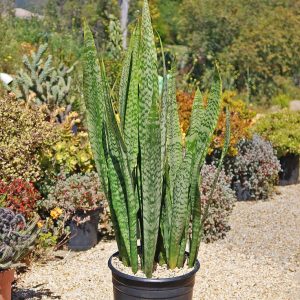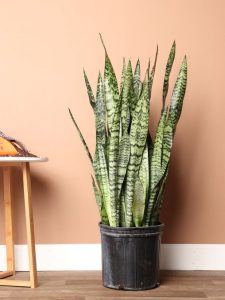Sansevieria Zeylanica

- Botanical Name:
- Family Name:
- Stems:
- Temperature:
- Others:
Overview
Product Description
Sansevieria Zeylanica: Versatile Tropics in a Pot
Sansevieria Zeylanica: An Overview of Origin and Habits
Origin of Sansevieria Zeylanica
Also known as Ceylon bowstring hemp or snake plant, is a perennial evergreen plant native to tropical Africa and also found in Sri Lanka and India. It belongs to the Asparagaceae family and is known for its upright, rigid, fleshy leaves that can grow up to 45-75 cm or longer in length and about 25 mm wide.

Sansevieria Zeylanica Fan
Habit and Care of Sansevieria Zeylanica
It is a highly adaptable plant that thrives in light but can also tolerate shade. It is not particular about soil, preferring well-drained sandy soil. This plant prefers warm and humid conditions but is also drought-tolerant. The optimal growth temperature for Sansevieria Zeylanica is between 20-30°C, and it is recommended to keep it above 10°C during the winter.
This plant has low water requirements and is a low-maintenance plant suitable for both beginners and experienced plant enthusiasts. It typically grows in drier areas, such as between rocks in Sri Lanka. Additionally, It is a drought-resistant plant, and established plants are very tolerant of dry conditions.
The Colorful World of Sansevieria Zeylanica: A Play of Light, Temperature, and Soil
The Fashion Show of Leaves
Sansevieria Zeylanica, also known as the devil’s tongue, stands out in the plant world with its unique leaf styling. Imagine them as a group of models wearing light green attire, standing on a 30 cm high runway, displaying their fashionable posture in clusters of 8-15 leaves, occasionally dotted with dark green spots, as if they were the clever embellishments of a fashion designer.
The Master of Colors
Light is the master behind the color changes of Sansevieria Zeylanica leaves. It not only determines the brightness of the leaves but also affects the synthesis of anthocyanins within the leaves, like the pigments on a palette, where light intensity, quality, and duration are the keys to coloring. If you want the leaves to be more vibrant, let them enjoy a sunbath in full sunlight.
The Magic of Temperature
Temperature, the magician of nature, also plays a significant role in the color changes of Sansevieria Zeylanica leaves. Low temperatures are like casting a spell, inducing the plant to synthesize more anthocyanins and making the leaf color richer. So, if the color of your Sansevieria Zeylanica leaves isn’t bright enough, try giving it a “cold treatment.”
The Alchemy of Soil

Sansevieria Zeylanica
Soil conditions are the alchemists of color change in it leaves. pH levels, water content, and the types and amounts of mineral elements all play a role in this alchemical process. The acidity or alkalinity of soil pH is like the heat in alchemy, affecting the synthesis and display of anthocyanins. Want to adjust the leaf color? You’ll have to study the alchemy of soil well.
Sansevieria Zeylanica: The Multifaceted Marvel
Sovereign of Indoor Greenery
Sansevieria Zeylanica, with its sturdy leaves and elegant form, has become the darling of indoor decoration. Whether in homes, restaurants, or hotels, this plant can add a touch of natural greenery to any space with its unique charm.
Air Guardian
Sansev ieria Zeylanicais not just an ornamental plant; it is also a warrior in air purification. Research by NASA has proven that this plant can effectively absorb harmful gases such as benzene and formaldehyde, bringing fresh air to indoor environments and making it an indispensable green companion in modern homes.
Guardian of Traditional Crafts
In the Yucatan Peninsula of Mexico, Sansevieria Zeylanica is not only a part of nature but also the guardian of cultural heritage. It is used to make high-quality natural fibers for the production of traditional handicrafts such as hammocks, showcasing the irreplaceability of this plant in traditional crafts.










